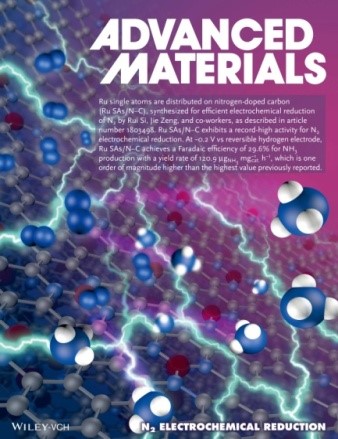Recently, the research group of Prof. Jie Zeng cooperated with Prof. Rui Si from Shanghai Institute of Applied Physics has made a breakthrough in NH3 production from electrochemical reduction of N2 by using Ru single-atom distributed on nitrogen-doped carbon (Ru SAs/N-C) as electrocatalysts. Ru SAs/N-C possessed a record-high yield rate for NH3 production toward N2 electrochemical reduction. This work was published on Advanced Materials (Adv. Mater. 2018, 30, 1803498) entitled as “Achieving a Record-High Yield Rate of 120.9 μgNH3 mg-1cat. h-1 for N2 Electrochemical Reduction over Ru Single-atom Catalysts”. Dr. Zhigang Geng and graduate student Yan Liu were the co-first authors of this work.
Nitrogen is nutritionally unavailable due to the highly stable N≡N covalent triple bond. As such, high pressure and temperature (150-350 atm, 350-550 oC) are required to convert N2 to NH3 through Haber-Bosch process in industry. The harsh condition of Haber-Bosch process results in 1-2% of the world’s annual energy supply consumption. Moreover, the NH3 synthesis through Haber-Bosch process requires hydrogen gas as source, which is generated from the steam reforming of natural gas with a large concomitant emission of CO2. In view of the fossil fuels shortage and global climate change, it is highly desired to explore a catalytic process that produces NH3 under ambient conditions. As a strategy of NH3 synthesis under the ambient reaction condition, electrochemical reduction of N2 into NH3 has attracted particular attention. However, to date, the highest NH3 yield rate among the reported electrocatalysts was only 23.8 μgNH3 mg-1cat. h-1 towards N2 electrochemical reduction. Therefore, the development of highly active electrocatalysts for NH3 production is desirable but remains challenging.
Herein, researchers prepared Ru SAs/N-C via pyrolyzing the Ru-containing derivative of zeolitic imidazolate frameworks (ZIF-8) which achieved record-high activity towards N2 electrochemical reduction. At -0.2 V vs reversible hydrogen electrode, Ru SAs/N-C exhibited a Faradaic efficiency of 29.6% for NH3 production with partial current density of -0.13 mA cm-2. Notably, the yield rate of Ru SAs/N-C reached 120.9 μgNH3 mg-1cat. h-1, which was one order of magnitude higher than the highest value ever reported. Experimental result and theoretical calculation study further revealed that Ru SAs/N-C promoted N2 dissociation, thereby resulting in enhanced activity. This work provides a guideline for the generation of atomically dispersed uniform single atomic materials and paves a new avenue for further research in the application of single atomic catalysts towards N2 electrochemical reduction.
This work was supported by CAS, MOST of China, National Natural Science Foundation of China, and Anhui Provincial Key Scientific and Technological Project.

Source: https://onlinelibrary.wiley.com/doi/epdf/10.1002/adma.201803498

